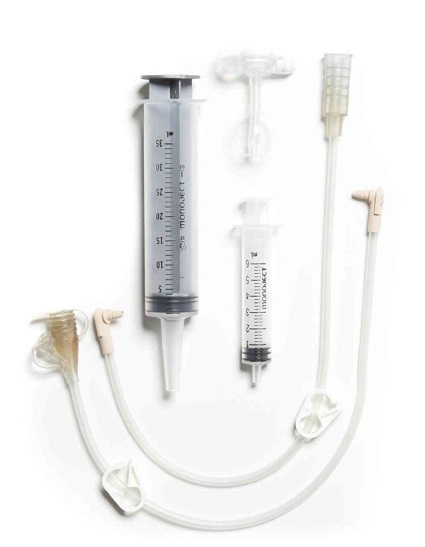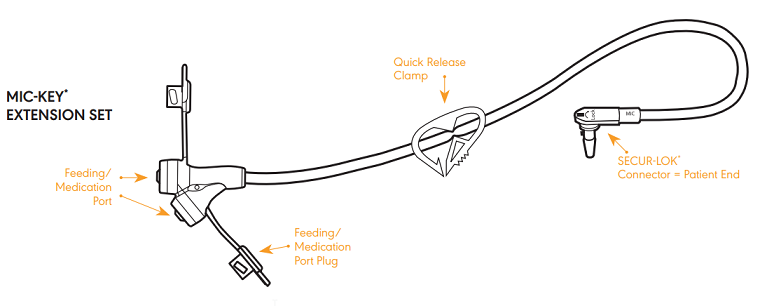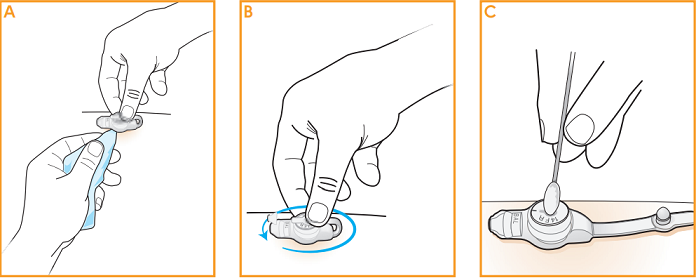Mickey 81401825 Gastrostomy Feeding Tube Each
Who Uses This Product? Individuals who need to be fed enterally but do not want a feeding tube to disrupt their daily lives.
Why They Love This Product: The Low-Profile Gastrostomy Feeding Tube is smaller than a percutaneous endoscopic gastronomy (PEG) tube. It sits close to the skin and doesn't need to be taped in place. It won't catch on clothing or pull during day-to-day activities.
MIC-KEY Low-Profile G Tube Overview
The MIC-KEY Low-Profile Gastrostomy Feeding Tube is a gastronomy feeding tube (g-tube) that is inserted through the belly and allows feeding to be done enterally. It is made of medical-grade silicone that is specifically designed for compatibility with the human body. The G-tube's port sits close to the skin and doesn't need to be taped in place or covered with gauze to protect it. Instead, it can easily be concealed with clothing. The low-profile design means that it won't get in the way, won't pull, and won't cause discomfort during daily activities. An anti-reflux valve prevents stomach contents from leaking out.
Features and Benefits
- Unobtrusive and Easy To Conceal
- Designed for Visibility and Drapability for Best Feeding Experience
- SECUR-LOK Feature Locks Feeding Tube in Place
- Universal Connector
- Connector Design Helps Prevent Accidental Disconnection
- Sits at Skin Level -- Reduces Interference With Clothing
- Available in Multiple French and Stoma Sizes To Fit Most Adults
- Medical-Grade Silicone Is Less Likely To Be Rejected by the Body
- Anti-Reflux Valve Keeps Gastric Fluids From Leaking Out
- Latex-Free and Sterile
Inconspicuous and Unobtrusive
The MIC-KEY Low Profile Gastrostomy Feeding Tube Kit With Secur-Lok / ENFit-Connector is unlike a percutaneous endoscopic gastronomy (PEG) tube in that it is a "button"-style tube instead of a long one. A typical PEG tube leaves several inches of tubing that protrudes from the skin and hangs loosely. In comparison, the low-profile g-tube valve protrudes from the skin and sits flat against it. There is no cord to snag on clothing, backpacks, or other accessories during day-to-day activities. Patients can go about their daily lives without fear that their movements will dislodge or pull on the g-tube.
What Comes in the Box?
- MIC-KEY low-profile feeding tube
- MIC-KEY extension set with SECUR-LOK right angle connector
- MIC-KEY bolus extension set with cath tip, SECUR-LOK straight connector
- 6-milliliter syringe
- 35-milliliter catheter tip syringe
- Directions for use
- Patient care guide

How To Use
Using an enteral feeding tube can seem complicated and frightening at first. In actuality, it is very uncomplicated. Feeding and administering medication can both be done at home or on the go. There are two types of tube feeding methods: bolus (syringe) feeding and pump feeding. The method is determined by a medical professional after discussions with the patient or caregiver.

Bolus Feeding
Bolus feeding is when formula is delivered from a syringe through the feeding tube. It is also known as syringe feeding or gravity feeding because of the way the syringe is held: upright, allowing gravity to aid the flow of the liquid. Feedings occur every three to four hours. It should take approximately 15 to 20 minutes to deliver 8 ounces of formula. For best results, make sure to sit upright during the feeding and for roughly 30 minutes after.
- Make sure the hands, equipment, and the outside of the formula container are clean.
- Prime the extension tube to remove any air. This will help prevent air from entering the stomach and causing discomfort. To prime the tube, flush it with room-temperature water with the 35-milliliter syringe.
- Once the extension tube is filled with water, engage the clamp. Remove the syringe from the extension tube and take the plunger out of the syringe. Re-insert the syringe (minus plunger) into the extension tube.
- Line up the extension tube with the MIC-KEY feeding port and rotate clockwise to lock it in place.
- Open the formula container. Hold the tube and syringe with one hand and slowly pour the formula into the syringe with the other. Allow gravity to pull the formula into the stomach. Add additional formula to the syringe as needed. Note: Keep the syringe filled to prevent air from entering the stomach.
- When the syringe is nearly empty, add the prescribed amount of water to the syringe.
- After administering the formula and water, engage the clamp on the extension tube. Fill the syringe with 10 to 20 milliliters of warm water. Reinsert the syringe plunger and unclamp the tube. Flush the extension set until the tube is clear.
- Unlock the extension tube by rotating it counter-clockwise until the black line on the extension tube lines up with the line on the feeding port. Gently remove the extension set and cap the MIC-KEY G-tube.
- Wash the extension set with warm, soapy water until the tube is clear. Rinse thoroughly with clear water.
The speed of the feeding can be adjusted to fit the patient's needs and preferences. To feed more quickly, hold the syringe higher than the stomach or use the plunger to push the formula through. To feed more slowly, hold the syringe lower than the stomach. If problems such as vomiting, diarrhea, or nausea occur during or after feeding, the speed may need to be reduced.
Bolus Feeding (3:08 minutes)
Continuous Feeding
Continuous feeding uses a feeding pump instead of a syringe. The pump provides formula at a set rate and is usually slower than a bolus feeding. Healthcare professionals may have recommendations for what pump is best for individual patients' situations.
- Connect the tube feeds to the feeding set, then connect the feeding set to the MIC-KEY extension set.
- Purge air from the feeding tube by allowing the tube feeds to run through it. When the feed reaches the end of the MIC-KEY extension set, engage the clamp.
- Insert the extension tube into the MIC-KEY G-tube and rotate clockwise to lock it in place.
- Connect the feeding set to the pump. Set the pump rate according to any instructions given by a medical professional or the pump manufacturer.
- Unclamp the extension tube and begin feeding.
- When the feeding is nearly finished, add water in the prescribed amount.
- After administering the formula and water, disconnect the feeding set from the MIC-KEY extension set.
- Flush the MIC-KEY extension set using the ENFit syringe and 10 to 20 milliliters of warm water. The tube should be clear when finished.
- Unlock the extension tube by rotating it counter-clockwise until the black line on the extension tube lines up with the line on the feeding port. Gently remove the extension set and cap the MIC-KEY G-tube.
- Wash the extension set with warm, soapy water until the tube is clear. Rinse thoroughly with clear water.
Accidental Removal
While the balloon on the MIC-KEY G-tube is meant to keep the unit in place, the balloon may deflate over time. Occasionally, this leads to unexpected removal of the tube. If this happens, the tube will need to be reinserted as soon as possible since the stoma site can close quickly. Replacing the G-tube can be done at home or with the aid of a medical professional.
Do not panic. Unless there is blood or pus, there is no major concern.
- Wash the hands thoroughly with warm water and soap.
- Check the stoma site for any redness or raised skin.
- Deflate the balloon all the way with the catheter tip syringe.
- Apply a liberal amount of lubricant to the G-tube.
- Reinsert the G-tube into the stoma.
- Reinflate the balloon with the syringe using the recommended amount of water.
- If necessary, check the placement of the tube with an extension kit.
Contact a Medical Professional If:
- The stoma is bleeding.
- There is blood mixed with stomach content.
- The stoma is persistently red or sore.
- There is an odor.
- The skin around the stoma is swollen.
- There is pus around the stoma.
- There is consistent pain or a fever.
Frequently Asked Questions (FAQs)
What is a low profile G-tube?
A feeding tube that provides fluids, nutrition, and medications directly to the small intestine. It sits close to the skin and is discreet.
What is the difference between a PEG tube and a MIC-KEY gastrostomy button?
The products perform the same function, which is enteral feeding. The MIC-KEY Low-Profile G-Tube sits unobtrusively at the level of the skin, whereas a PEG tube hangs loosely from the patient's abdomen.
How often should the MIC-KEY be replaced?
It is recommended that the MIC-KEY low profile G-tube be replaced at least once every three months.
Does rotating the tube hurt?
No. Rotating the tube should not hurt. If it does, contact a healthcare professional.
A Formula to Suit Every Need
A feeding port allows medication or liquid nutrients to be delivered directly into the stomach via a feeding tube. Vitality Medical offers a variety of tube feeding formulas for adults and children.
- Abbott PediaSure Balanced Nutrition is specifically for children and contains 25 essential vitamins and minerals.
- Glucerna Specialized Nutrition for Glycemic Control is a calorie-dense formula for patients with diabetes and hyperglycemia.
- Jevity High-Protein Nutrition With Fiber is an unflavored and calorie-dense nutritional supplement high in fiber and probiotics.
Cleaning and Care Tips
Keeping the MIC-KEY Low-Profile G-tube clean is just as important as the feeding process.
Cleaning the Low-Profile G-Tube
- Wash hands before touching the G-tube.
- The MIC-KEY low profile feeding tube and the skin around and under the tube should be cleaned once a day. Cleaning can be done with water and a mild soap as well as tissues or cotton-tip applicators.
- Keep the tube and the skin around the tube (stoma) clean and dry.
- Rotate the MIC-KEY gastrostomy tube in a full circle during the daily cleaning process. Make sure not to pull or manipulate the tube more than necessary.

Note: The extension set should be replaced at least once every two weeks for better functionality and hygiene.
Cleaning the Extension Tube
- Wash hands before touching the tube.
- Wash the extension set with warm, soapy water until the tube is clear. Rinse thoroughly with clear water.
Specifications
- Manufacturer: MIC-KEY
- Tube Tip Type: Tapered Distal, Recessed Distal
- Balloon Volume: 5 Milliliters
- French Sizes: 12, 14, 16, 18, 20, 24
- Stoma Lengths (Centimeters): 0.8, 1.0, 1.2, 1.5, 1.7, 2.0, 2.3, 2.5, 2.7, 3.0, 3.5, 4.0
- Material: Medical-Grade Silicone
- Application: Enteral Feeding Tube
- Product Numbers: BLD01201208, BLD01201210, BLD01201212, BLD01201215, BLD01201217, BLD01201220, BLD01201645, BLD01202050, BLD01201408, BLD01201410, BLD01201412, BLD01201415, BLD01201417, BLD01201420, BLD01201423, BLD01201425, BLD01201427, BLD01201430, BLD01201435, BLD01201440
Related MIC-KEY Products
- MIC-Key Tube Extension Feeding Sets - Bolus and Non-Bolus Options, 12 or 24 Inch Length.
- Halyard MIC-KEY Jejuanl Feeding Tubes - Silicone 14 and 18 French with 1.0 to 4 cm length.
- Avanos MIC-KEY Gastric-Jejunal (GJ) Feeding Tube Kit - Secur-Loc connection with 16, 18, & 22 French Sizes, 1.0 to 3.5 cm Stoma Length, 15 to 45 cm Jejunal Length, and 3 to 10 ml Balloon Volume.
- MIC-KEY Low Profile Button Jejunal Feeding Tube - Trimable Distal Tip, 14 or 18 French Size 1.0 to 4.0 Stoma Size.
- Kimberly Clark MIC-KEY BOLUS Gastrostomy Feeding Tube - Tapered Distal Tip, Dual Exit Ports, 14 to 24 French Size.
- Kimberly Clark MIC-KEY G-Tube Gastrostomy Feeding Tube - Built-in Medicine Port, Non-Recessed Distal Tip, Dual Exit Ports, 12 to 30 French Size.
- Over-The-Wire Stoma Measuring Device for MIC-KEY Tubes - determines correct feeding tube shaft length.
Manuals and Documents
Product Videos
Life With the MIC-KEY Low Profile Feeding Tube (10:25 minutes)
Feeding Tube Skills: Giving Medication (3:27 minutes)
Feeding Tube Skills: Replacing the Gastrostomy Tube (3:14 minutes)
Source: https://www.vitalitymedical.com/ballard-kimberly-clark-mic-key-tube-low-profile-gastrostomy-tube-kit.html
0 Response to "Mickey 81401825 Gastrostomy Feeding Tube Each"
Post a Comment